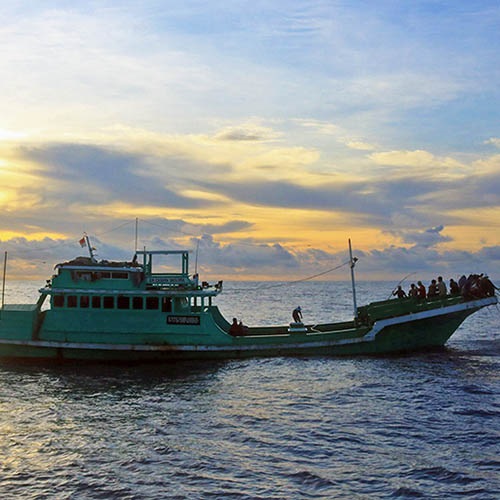Ensuring MSC certified fisheries do not prevent the recovery of endangered, threatened and protected species is vital to achieving our mission of safeguarding ocean health.
How has our Standard changed?
The new version of the MSC Fisheries Standard represents a significant strengthening of our requirements on ETP species, which were last revised substantively in 2008.
The new Standard includes a new classification system to ensure species are consistently and objectively classified as ETP. More species, including all marine mammals, birds, amphibians, and reptiles (out-of-scope species), are automatically subject to
the new requirements and afforded greater protections. These changes also mean more shark species will be given greater protection through the standard.
The impacts of fisheries on ETP populations must be assessed more explicitly
and through a more precautionary approach. Fisheries must now provide quantifiable evidence that they have effective management measures in place to reduce impacts on ETP and out -of-scope species, in alignment with best practice.
Find out more about our new requirements for ETP and out-of-scope species below.
Improved method for classification of endangered, threatened and protected species
We have revised our requirements for designating species as ETP to ensure assessors are taking a consistent and precautionary approach, in alignment with the UN FAO Code of Conduct for Responsible Fisheries.
This will ensure species are being objectively and accurately classified as ETP, and that more species - including all out-of-scope species - are now subject to the proposed ETP requirements.
The new requirements include expanding
the application of international species lists of CITES, CMS and IUCN to include more species. For example,
CITES Appendix 2 species and both CMS Appendix 1 and 2 species have now been added to species lists requiring consideration.
We have also introduced a new two-step process for determining if in-scope species, which are
those that can be targeted by MSC certified fisheries (finfish and invertebrates), should be classified and assessed as ETP:
- Step 1: Establish whether the species features on specific international and national lists of ETP species.
- Step 2: Apply a set of scientific criteria – stock status, management status or species life history - to reclassify species as either target catch under Principle 1, or to be assessed against the In-Scope species component under Principle 2. Our In-scope species component typically assesses other species caught that are eligible for certification (finfish and invertebrates) but are not the focus of certification.
Allowing species to be reclassified if they meet these criteria will mean well-managed populations, or populations which are inherently resilient to exploitation, can be eligible for MSC certification. This enables assessors to respond to real-time data on a species and fishery, rather than being fully reliant on listings which may not be up to date.
Better protections for sharks
We have also designed our new ETP classification system with greater precaution for sharks. Sharks which are protected under national ETP legislation or those identified by IUCN as endangered, critically endangered, or listed as CITES or CMS Appendix
1 species all automatically qualify as ETP species (so cannot be eligible for MSC certification).
In certain circumstances, sharks listed on CITES Appendix 2 and CMS Appendix 2 may be assessed under Principle 1 or subject to our requirements
for in-scope species rather than ETP/Out-of-Scope. However, this can only occur only if the specific stock meets the scientific criteria set out in Step 2 of the process detailed above, demonstrating that the specific stock has a healthy population
size and is well-managed.
To ensure sharks are better protected, we have also expanded the definition of ‘shark’ to include all shark species (from the class Chondrichthyes) for the purposes of classifying a species as
endangered, threatened, or protected. The definition of a shark (Rhinopristiformes and Selachimorpha) remains unchanged in relation to our shark finning requirements.
More explicit consideration of fishery impacts on populations and improved management
Assessors must now explicitly consider whether a fishery is hindering the recovery of an ETP or out-of-scope population during an assessment. The new Standard therefore includes new definitions and concepts specifying how the impact of a fishery on ETP
or out-of-scope population recovery should be measured. This will ensure assessments are more objective and quantifiable and increase confidence that only fisheries that can prove they are not impacting populations or harming recovery achieve MSC
certification.
Under the new requirements, assessors must now consider whether a fishery is impacting a species’ ability to recover to a minimum of ‘50% of unimpacted levels within three generations or 100 years, whichever is shorter’.
This is a type of reference point we refer to as Favourable Conservation Status. The differing life histories of each species will impact a population’s recovery time, and so we have provided assessors with guidance on how to evaluate different
species groups.
Fisheries must also explicitly show how they are effectively minimising mortality of ETP or out-of-scope species. Our requirements on the assessment of indirect impacts and unobserved mortality and additional guidance
developed to ensure the intent of our Standard is clear.
International compliance
Assessors must also evaluate a fishery’s compliance with national and international regulations for protecting ETP species. These requirements will be assessed under Principle 3 and will ensure assessments are more objective and consistent.
Demonstrating practices do not impact marine mammal populations
Fisheries engaged in practices that involve the intentional harassment or intentional killing of marine mammals as an integral part of their fishing operation, will now be required to provide a high level of proof that marine mammal populations are healthy.
This approach accords with the MSC’s ethos to incentivise improvements in sustainability and drive change based on science and evidence.
Very few fisheries in the MSC program use these methods. However, the new requirements will ensure
that fisheries deliberately setting on marine mammals such as dolphins in order catch other species or using marine mammals as live fish aggregation devices (FADs), for example, will have to adopt a very high burden to proof to demonstrate that these
practices are not affecting the health of the marine mammal population.
The burden of proof required by fisheries engaging in these practices is unprecedented - they need to establish impacted populations have fully recovered with a high level of certainty. This includes using very recent population assessments. As a further
precautionary step, scoring will be capped at SG80.
Links to other outcomes from the Fisheries Standard Review
To ensure ETP species are scored more consistently, we need to make sure fishery assessments are based on a robust and consistent standard of information.
This will be achieved through the use of our new Evidence Requirements Framework tool, which will provide assessors with a consistent and systematic approach to judging the quality of information provided
by a fishery.
We have also updated our Risk-Based Framework,
which is used to support the assessment of fisheries with limited data. This includes new more accurate assessment criteria for out-of-scope species. This will ensure it delivers precautionary and robust outcomes.
Fisheries Standard 3.0 implementation
Developing our policies
In 2022, we published Version 3.0 of the MSC Fisheries Standard following the most comprehensive review to date.
The development of the Standard follows public consultation on key aspects of the review,
including a 60-day public review of the draft Standard and all associated documents.
We also commissioned independent research and carried out data analysis and impact assessments to determine whether proposals are feasible and deliver
our stated intentions. We also sought advice and input from our governance bodies throughout the process.
Follow the links below to find out more about the different inputs which contributed to the development of our new requirements for reducing impacts on ETP and Out-of-Scope species:
- Impact Assessment Report – Endangered, threatened and protected species (Nov 2021)
- Impact Assessment Report - Intentional harassment and intentional killing of marine mammals (August 2022)
- Impact Assessment Report - Scope Criteria (November 2021
- Consultation summary report – Proposed revised MSC Fisheries Standard (May 2022)
- Consultation summary report – Clarifying best practice for reducing impacts on endangered, threatened and protected species (July 2021)
- Consultation summary report - Clarifying best practice for reducing impacts on endangered, threatened and protected species – (October 2020)
- National Plans of Action (NPOAs) for reducing seabird bycatch: Developing best practice for assessing and managing fisheries impacts – SD Good, GB Baker, M Gummery, SC Votier, RA Phillips (July 2020)
- Identifying Out of Scope Fisheries – Smith R, Fortuna C (2021)
- Global review on intentional harassment of marine mammals – Fortuna C (2019)
Additional consultants reports listed below are available on request. Please contact [email protected].
- Review of MSC requirements for ETP species – Stage 1
- Review of MSC requirements for ETP species – Stage 2
- Review of MSC requirements for ETP species – Stage 3
- Review of MSC requirements for ETP species – Summary report
- ETP requirements on population impact and minimisation of mortality
- Summary of expert responses for ETP management and outcome options

MSC Fisheries Standard version 3.0
An overview of the changes made to our Standard.

Fisheries Program Documents
The MSC Fisheries Standard and General Certification Requirements.

.tmb-labelhome.jpg?Status=Master&Culture=en&sfvrsn=39466bd9_3)